Exploring STM to LTM Transfer: An Essay for ARTS 1110 at Manitoba
VerifiedAdded on 2022/08/15
|9
|2008
|14
Essay
AI Summary
This essay, written for ARTS 1110 at the University of Manitoba, investigates the process of transferring information from short-term memory (STM) to long-term memory (LTM). It examines the roles of rote learning, rehearsal, and recording as key techniques in this transfer, and how these methods contribute to the formation of neural networks in the brain. The essay explores the hypothesis that these techniques facilitate systematic learning and enhance long-term memory. It discusses the limitations of rote memorization and highlights the effectiveness of techniques such as elaborative rehearsal, note-taking, and color-coding. Furthermore, it delves into the concept of neural networks and how they relate to the storage and retrieval of memories. The essay concludes by affirming the hypothesis and emphasizing the importance of these techniques for improved memory transfer, retention, and recall. The essay uses references from O’Brien Mora, Crook, and other researchers.
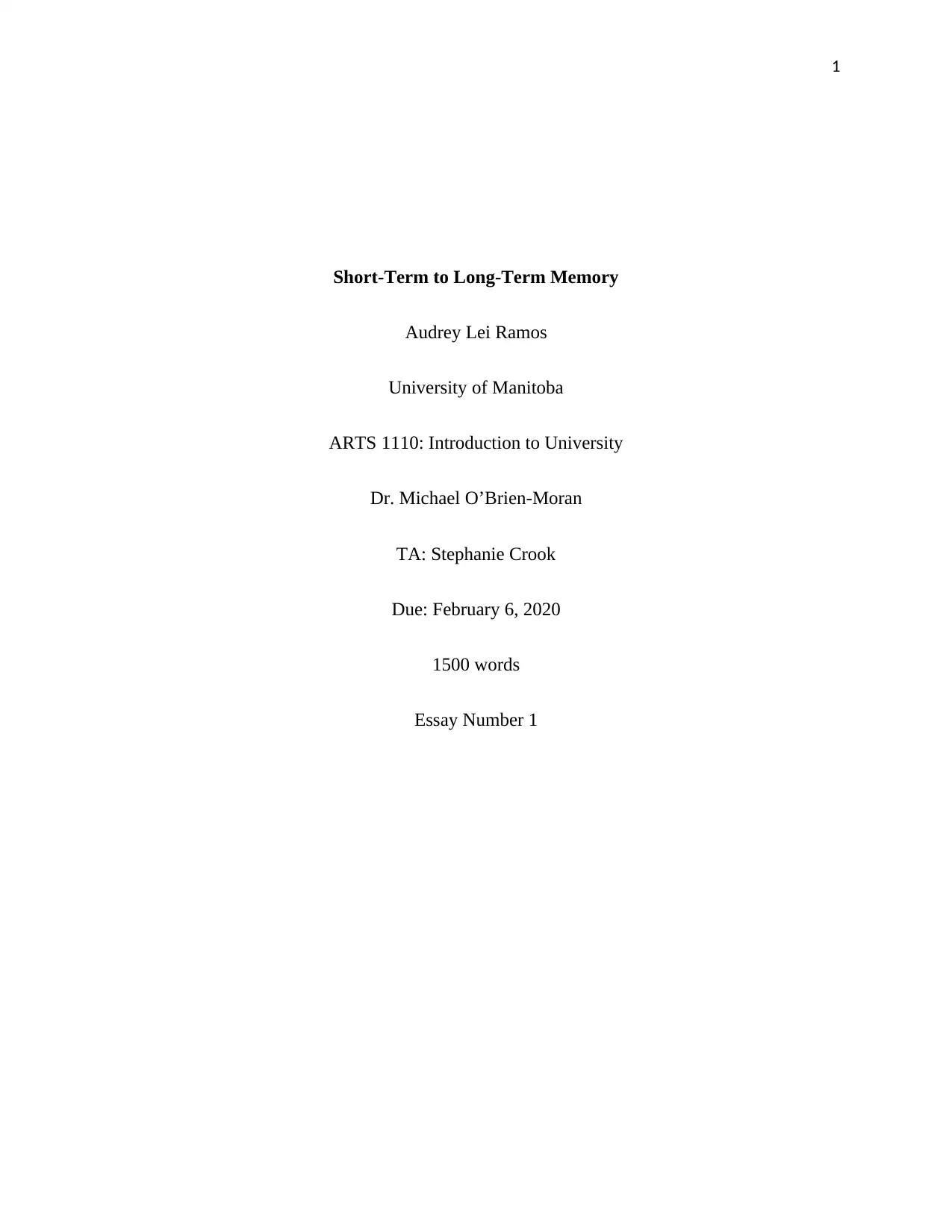
1
Short-Term to Long-Term Memory
Audrey Lei Ramos
University of Manitoba
ARTS 1110: Introduction to University
Dr. Michael O’Brien-Moran
TA: Stephanie Crook
Due: February 6, 2020
1500 words
Essay Number 1
Short-Term to Long-Term Memory
Audrey Lei Ramos
University of Manitoba
ARTS 1110: Introduction to University
Dr. Michael O’Brien-Moran
TA: Stephanie Crook
Due: February 6, 2020
1500 words
Essay Number 1
Paraphrase This Document
Need a fresh take? Get an instant paraphrase of this document with our AI Paraphraser
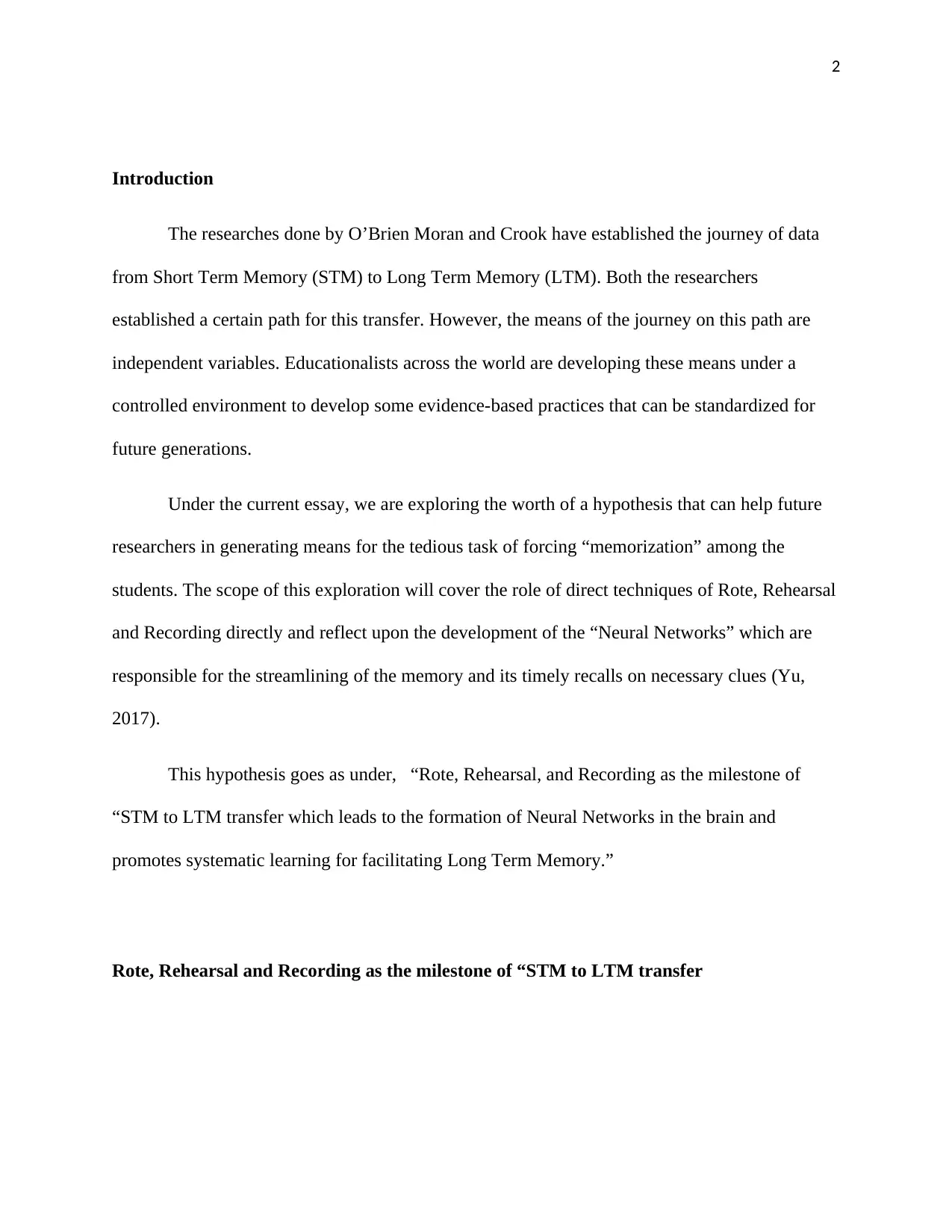
2
Introduction
The researches done by O’Brien Moran and Crook have established the journey of data
from Short Term Memory (STM) to Long Term Memory (LTM). Both the researchers
established a certain path for this transfer. However, the means of the journey on this path are
independent variables. Educationalists across the world are developing these means under a
controlled environment to develop some evidence-based practices that can be standardized for
future generations.
Under the current essay, we are exploring the worth of a hypothesis that can help future
researchers in generating means for the tedious task of forcing “memorization” among the
students. The scope of this exploration will cover the role of direct techniques of Rote, Rehearsal
and Recording directly and reflect upon the development of the “Neural Networks” which are
responsible for the streamlining of the memory and its timely recalls on necessary clues (Yu,
2017).
This hypothesis goes as under, “Rote, Rehearsal, and Recording as the milestone of
“STM to LTM transfer which leads to the formation of Neural Networks in the brain and
promotes systematic learning for facilitating Long Term Memory.”
Rote, Rehearsal and Recording as the milestone of “STM to LTM transfer
Introduction
The researches done by O’Brien Moran and Crook have established the journey of data
from Short Term Memory (STM) to Long Term Memory (LTM). Both the researchers
established a certain path for this transfer. However, the means of the journey on this path are
independent variables. Educationalists across the world are developing these means under a
controlled environment to develop some evidence-based practices that can be standardized for
future generations.
Under the current essay, we are exploring the worth of a hypothesis that can help future
researchers in generating means for the tedious task of forcing “memorization” among the
students. The scope of this exploration will cover the role of direct techniques of Rote, Rehearsal
and Recording directly and reflect upon the development of the “Neural Networks” which are
responsible for the streamlining of the memory and its timely recalls on necessary clues (Yu,
2017).
This hypothesis goes as under, “Rote, Rehearsal, and Recording as the milestone of
“STM to LTM transfer which leads to the formation of Neural Networks in the brain and
promotes systematic learning for facilitating Long Term Memory.”
Rote, Rehearsal and Recording as the milestone of “STM to LTM transfer
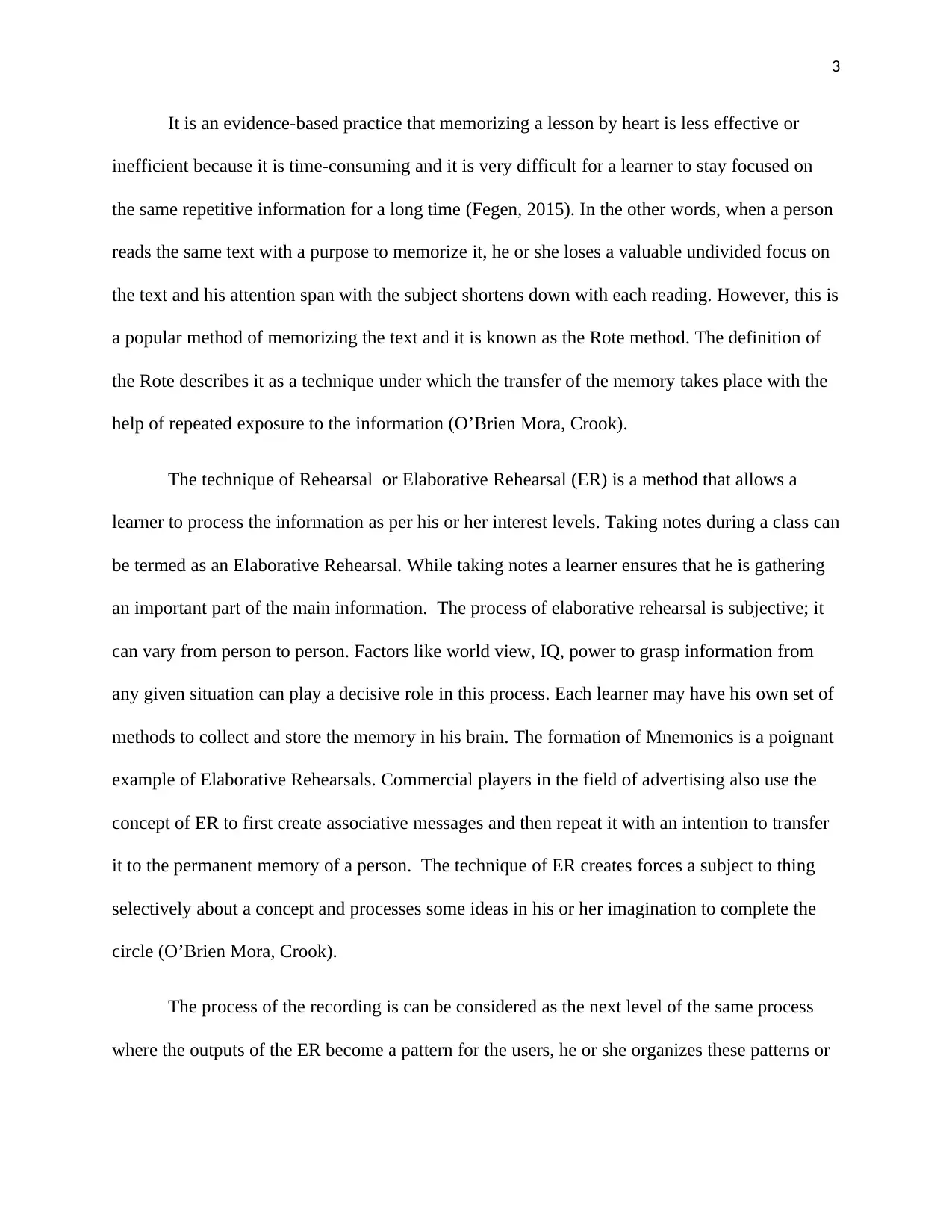
3
It is an evidence-based practice that memorizing a lesson by heart is less effective or
inefficient because it is time-consuming and it is very difficult for a learner to stay focused on
the same repetitive information for a long time (Fegen, 2015). In the other words, when a person
reads the same text with a purpose to memorize it, he or she loses a valuable undivided focus on
the text and his attention span with the subject shortens down with each reading. However, this is
a popular method of memorizing the text and it is known as the Rote method. The definition of
the Rote describes it as a technique under which the transfer of the memory takes place with the
help of repeated exposure to the information (O’Brien Mora, Crook).
The technique of Rehearsal or Elaborative Rehearsal (ER) is a method that allows a
learner to process the information as per his or her interest levels. Taking notes during a class can
be termed as an Elaborative Rehearsal. While taking notes a learner ensures that he is gathering
an important part of the main information. The process of elaborative rehearsal is subjective; it
can vary from person to person. Factors like world view, IQ, power to grasp information from
any given situation can play a decisive role in this process. Each learner may have his own set of
methods to collect and store the memory in his brain. The formation of Mnemonics is a poignant
example of Elaborative Rehearsals. Commercial players in the field of advertising also use the
concept of ER to first create associative messages and then repeat it with an intention to transfer
it to the permanent memory of a person. The technique of ER creates forces a subject to thing
selectively about a concept and processes some ideas in his or her imagination to complete the
circle (O’Brien Mora, Crook).
The process of the recording is can be considered as the next level of the same process
where the outputs of the ER become a pattern for the users, he or she organizes these patterns or
It is an evidence-based practice that memorizing a lesson by heart is less effective or
inefficient because it is time-consuming and it is very difficult for a learner to stay focused on
the same repetitive information for a long time (Fegen, 2015). In the other words, when a person
reads the same text with a purpose to memorize it, he or she loses a valuable undivided focus on
the text and his attention span with the subject shortens down with each reading. However, this is
a popular method of memorizing the text and it is known as the Rote method. The definition of
the Rote describes it as a technique under which the transfer of the memory takes place with the
help of repeated exposure to the information (O’Brien Mora, Crook).
The technique of Rehearsal or Elaborative Rehearsal (ER) is a method that allows a
learner to process the information as per his or her interest levels. Taking notes during a class can
be termed as an Elaborative Rehearsal. While taking notes a learner ensures that he is gathering
an important part of the main information. The process of elaborative rehearsal is subjective; it
can vary from person to person. Factors like world view, IQ, power to grasp information from
any given situation can play a decisive role in this process. Each learner may have his own set of
methods to collect and store the memory in his brain. The formation of Mnemonics is a poignant
example of Elaborative Rehearsals. Commercial players in the field of advertising also use the
concept of ER to first create associative messages and then repeat it with an intention to transfer
it to the permanent memory of a person. The technique of ER creates forces a subject to thing
selectively about a concept and processes some ideas in his or her imagination to complete the
circle (O’Brien Mora, Crook).
The process of the recording is can be considered as the next level of the same process
where the outputs of the ER become a pattern for the users, he or she organizes these patterns or
⊘ This is a preview!⊘
Do you want full access?
Subscribe today to unlock all pages.

Trusted by 1+ million students worldwide
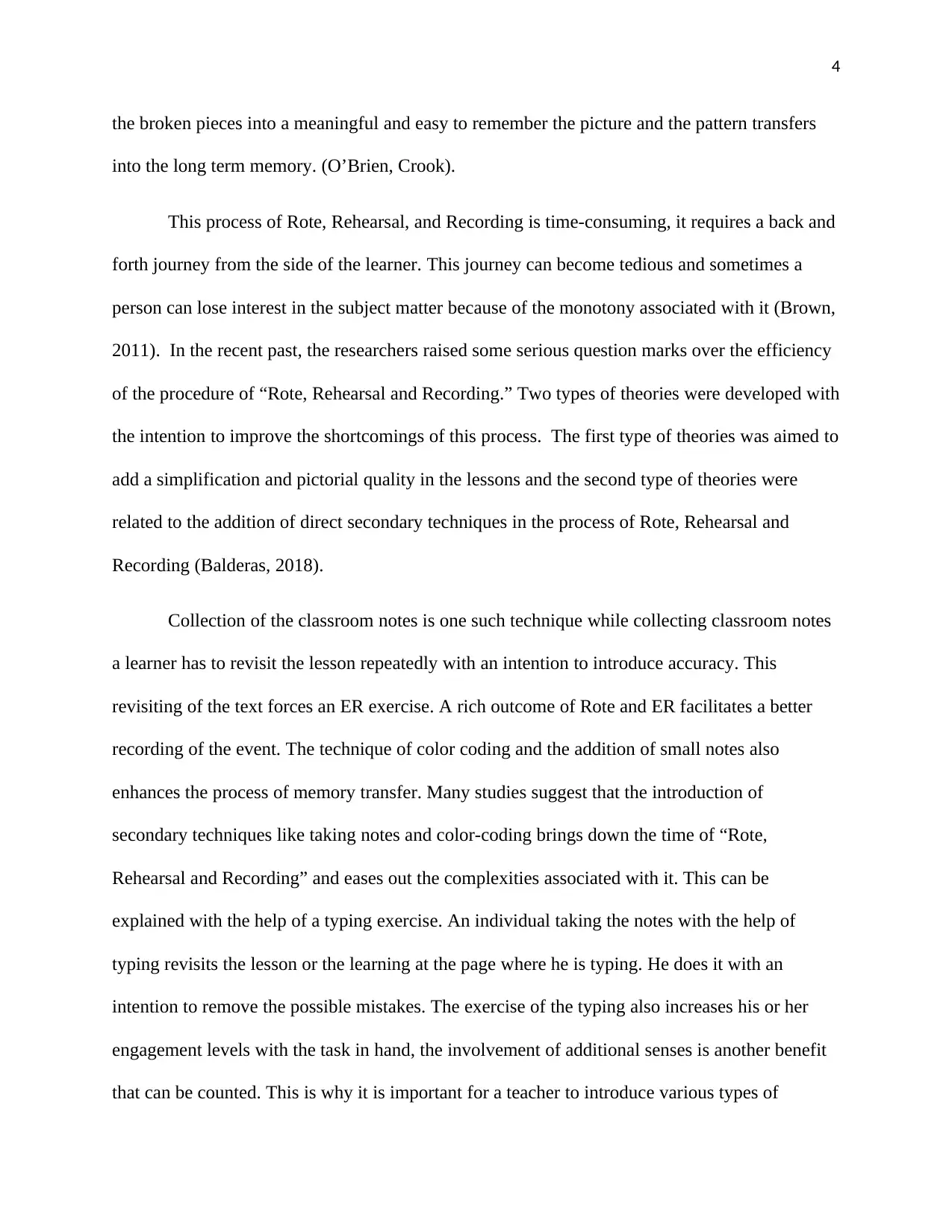
4
the broken pieces into a meaningful and easy to remember the picture and the pattern transfers
into the long term memory. (O’Brien, Crook).
This process of Rote, Rehearsal, and Recording is time-consuming, it requires a back and
forth journey from the side of the learner. This journey can become tedious and sometimes a
person can lose interest in the subject matter because of the monotony associated with it (Brown,
2011). In the recent past, the researchers raised some serious question marks over the efficiency
of the procedure of “Rote, Rehearsal and Recording.” Two types of theories were developed with
the intention to improve the shortcomings of this process. The first type of theories was aimed to
add a simplification and pictorial quality in the lessons and the second type of theories were
related to the addition of direct secondary techniques in the process of Rote, Rehearsal and
Recording (Balderas, 2018).
Collection of the classroom notes is one such technique while collecting classroom notes
a learner has to revisit the lesson repeatedly with an intention to introduce accuracy. This
revisiting of the text forces an ER exercise. A rich outcome of Rote and ER facilitates a better
recording of the event. The technique of color coding and the addition of small notes also
enhances the process of memory transfer. Many studies suggest that the introduction of
secondary techniques like taking notes and color-coding brings down the time of “Rote,
Rehearsal and Recording” and eases out the complexities associated with it. This can be
explained with the help of a typing exercise. An individual taking the notes with the help of
typing revisits the lesson or the learning at the page where he is typing. He does it with an
intention to remove the possible mistakes. The exercise of the typing also increases his or her
engagement levels with the task in hand, the involvement of additional senses is another benefit
that can be counted. This is why it is important for a teacher to introduce various types of
the broken pieces into a meaningful and easy to remember the picture and the pattern transfers
into the long term memory. (O’Brien, Crook).
This process of Rote, Rehearsal, and Recording is time-consuming, it requires a back and
forth journey from the side of the learner. This journey can become tedious and sometimes a
person can lose interest in the subject matter because of the monotony associated with it (Brown,
2011). In the recent past, the researchers raised some serious question marks over the efficiency
of the procedure of “Rote, Rehearsal and Recording.” Two types of theories were developed with
the intention to improve the shortcomings of this process. The first type of theories was aimed to
add a simplification and pictorial quality in the lessons and the second type of theories were
related to the addition of direct secondary techniques in the process of Rote, Rehearsal and
Recording (Balderas, 2018).
Collection of the classroom notes is one such technique while collecting classroom notes
a learner has to revisit the lesson repeatedly with an intention to introduce accuracy. This
revisiting of the text forces an ER exercise. A rich outcome of Rote and ER facilitates a better
recording of the event. The technique of color coding and the addition of small notes also
enhances the process of memory transfer. Many studies suggest that the introduction of
secondary techniques like taking notes and color-coding brings down the time of “Rote,
Rehearsal and Recording” and eases out the complexities associated with it. This can be
explained with the help of a typing exercise. An individual taking the notes with the help of
typing revisits the lesson or the learning at the page where he is typing. He does it with an
intention to remove the possible mistakes. The exercise of the typing also increases his or her
engagement levels with the task in hand, the involvement of additional senses is another benefit
that can be counted. This is why it is important for a teacher to introduce various types of
Paraphrase This Document
Need a fresh take? Get an instant paraphrase of this document with our AI Paraphraser
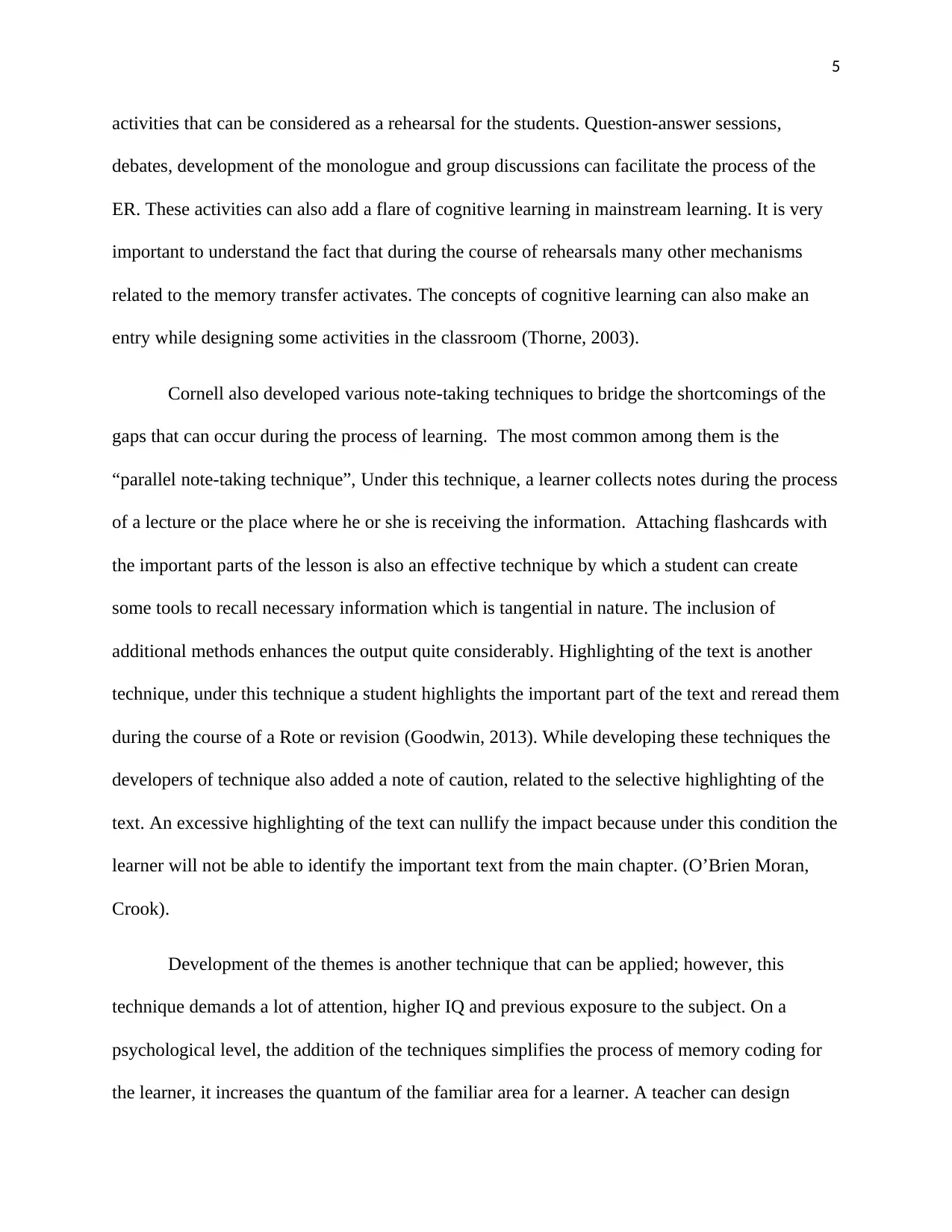
5
activities that can be considered as a rehearsal for the students. Question-answer sessions,
debates, development of the monologue and group discussions can facilitate the process of the
ER. These activities can also add a flare of cognitive learning in mainstream learning. It is very
important to understand the fact that during the course of rehearsals many other mechanisms
related to the memory transfer activates. The concepts of cognitive learning can also make an
entry while designing some activities in the classroom (Thorne, 2003).
Cornell also developed various note-taking techniques to bridge the shortcomings of the
gaps that can occur during the process of learning. The most common among them is the
“parallel note-taking technique”, Under this technique, a learner collects notes during the process
of a lecture or the place where he or she is receiving the information. Attaching flashcards with
the important parts of the lesson is also an effective technique by which a student can create
some tools to recall necessary information which is tangential in nature. The inclusion of
additional methods enhances the output quite considerably. Highlighting of the text is another
technique, under this technique a student highlights the important part of the text and reread them
during the course of a Rote or revision (Goodwin, 2013). While developing these techniques the
developers of technique also added a note of caution, related to the selective highlighting of the
text. An excessive highlighting of the text can nullify the impact because under this condition the
learner will not be able to identify the important text from the main chapter. (O’Brien Moran,
Crook).
Development of the themes is another technique that can be applied; however, this
technique demands a lot of attention, higher IQ and previous exposure to the subject. On a
psychological level, the addition of the techniques simplifies the process of memory coding for
the learner, it increases the quantum of the familiar area for a learner. A teacher can design
activities that can be considered as a rehearsal for the students. Question-answer sessions,
debates, development of the monologue and group discussions can facilitate the process of the
ER. These activities can also add a flare of cognitive learning in mainstream learning. It is very
important to understand the fact that during the course of rehearsals many other mechanisms
related to the memory transfer activates. The concepts of cognitive learning can also make an
entry while designing some activities in the classroom (Thorne, 2003).
Cornell also developed various note-taking techniques to bridge the shortcomings of the
gaps that can occur during the process of learning. The most common among them is the
“parallel note-taking technique”, Under this technique, a learner collects notes during the process
of a lecture or the place where he or she is receiving the information. Attaching flashcards with
the important parts of the lesson is also an effective technique by which a student can create
some tools to recall necessary information which is tangential in nature. The inclusion of
additional methods enhances the output quite considerably. Highlighting of the text is another
technique, under this technique a student highlights the important part of the text and reread them
during the course of a Rote or revision (Goodwin, 2013). While developing these techniques the
developers of technique also added a note of caution, related to the selective highlighting of the
text. An excessive highlighting of the text can nullify the impact because under this condition the
learner will not be able to identify the important text from the main chapter. (O’Brien Moran,
Crook).
Development of the themes is another technique that can be applied; however, this
technique demands a lot of attention, higher IQ and previous exposure to the subject. On a
psychological level, the addition of the techniques simplifies the process of memory coding for
the learner, it increases the quantum of the familiar area for a learner. A teacher can design
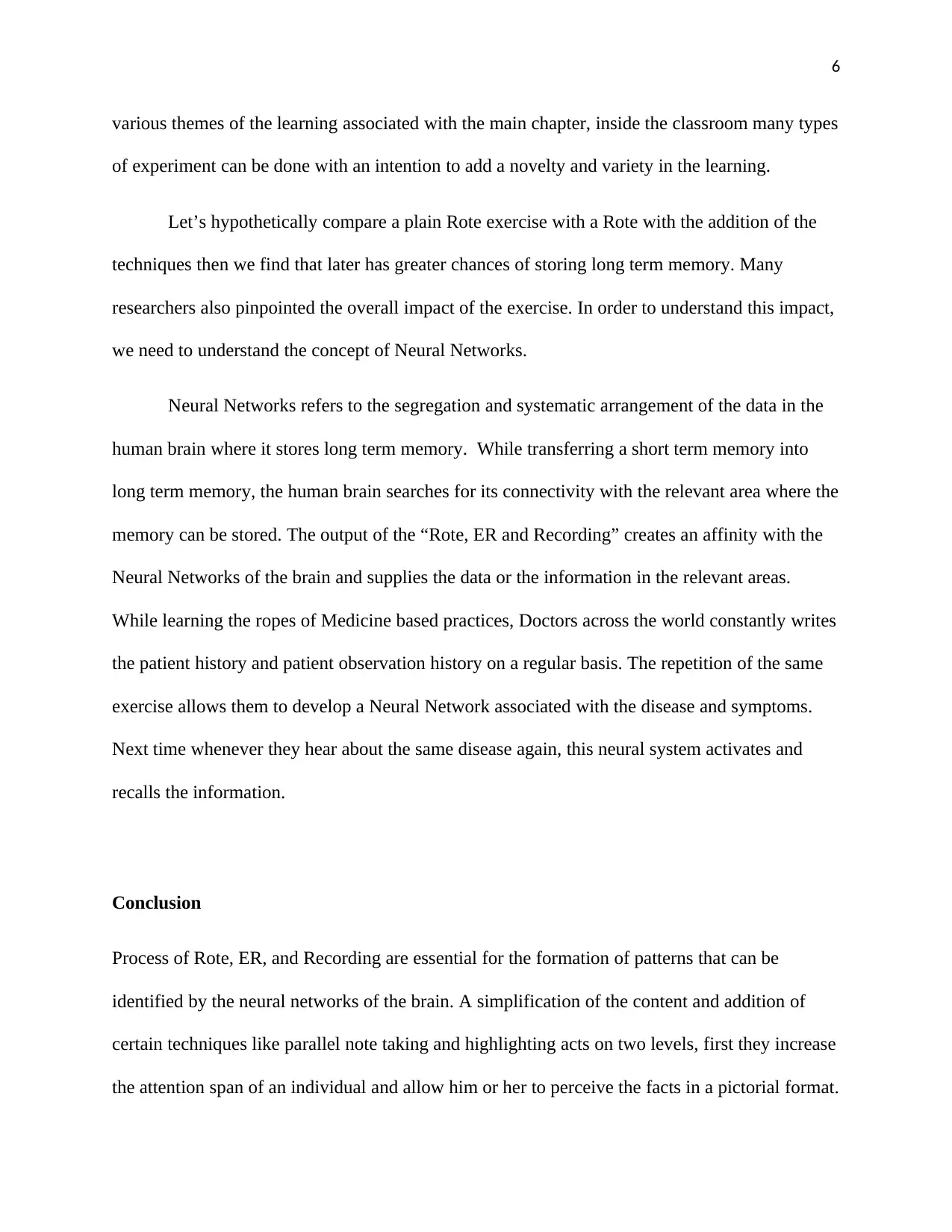
6
various themes of the learning associated with the main chapter, inside the classroom many types
of experiment can be done with an intention to add a novelty and variety in the learning.
Let’s hypothetically compare a plain Rote exercise with a Rote with the addition of the
techniques then we find that later has greater chances of storing long term memory. Many
researchers also pinpointed the overall impact of the exercise. In order to understand this impact,
we need to understand the concept of Neural Networks.
Neural Networks refers to the segregation and systematic arrangement of the data in the
human brain where it stores long term memory. While transferring a short term memory into
long term memory, the human brain searches for its connectivity with the relevant area where the
memory can be stored. The output of the “Rote, ER and Recording” creates an affinity with the
Neural Networks of the brain and supplies the data or the information in the relevant areas.
While learning the ropes of Medicine based practices, Doctors across the world constantly writes
the patient history and patient observation history on a regular basis. The repetition of the same
exercise allows them to develop a Neural Network associated with the disease and symptoms.
Next time whenever they hear about the same disease again, this neural system activates and
recalls the information.
Conclusion
Process of Rote, ER, and Recording are essential for the formation of patterns that can be
identified by the neural networks of the brain. A simplification of the content and addition of
certain techniques like parallel note taking and highlighting acts on two levels, first they increase
the attention span of an individual and allow him or her to perceive the facts in a pictorial format.
various themes of the learning associated with the main chapter, inside the classroom many types
of experiment can be done with an intention to add a novelty and variety in the learning.
Let’s hypothetically compare a plain Rote exercise with a Rote with the addition of the
techniques then we find that later has greater chances of storing long term memory. Many
researchers also pinpointed the overall impact of the exercise. In order to understand this impact,
we need to understand the concept of Neural Networks.
Neural Networks refers to the segregation and systematic arrangement of the data in the
human brain where it stores long term memory. While transferring a short term memory into
long term memory, the human brain searches for its connectivity with the relevant area where the
memory can be stored. The output of the “Rote, ER and Recording” creates an affinity with the
Neural Networks of the brain and supplies the data or the information in the relevant areas.
While learning the ropes of Medicine based practices, Doctors across the world constantly writes
the patient history and patient observation history on a regular basis. The repetition of the same
exercise allows them to develop a Neural Network associated with the disease and symptoms.
Next time whenever they hear about the same disease again, this neural system activates and
recalls the information.
Conclusion
Process of Rote, ER, and Recording are essential for the formation of patterns that can be
identified by the neural networks of the brain. A simplification of the content and addition of
certain techniques like parallel note taking and highlighting acts on two levels, first they increase
the attention span of an individual and allow him or her to perceive the facts in a pictorial format.
⊘ This is a preview!⊘
Do you want full access?
Subscribe today to unlock all pages.

Trusted by 1+ million students worldwide
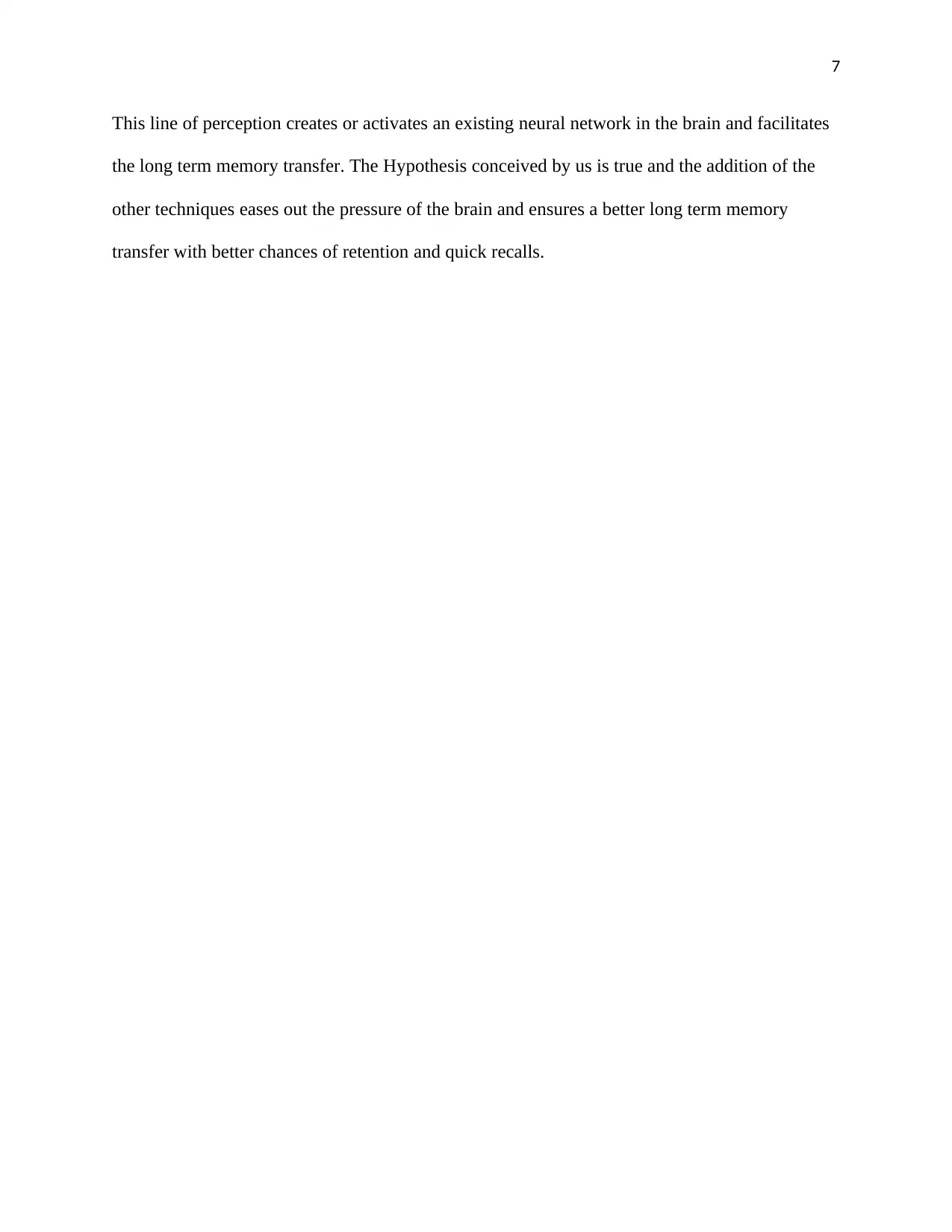
7
This line of perception creates or activates an existing neural network in the brain and facilitates
the long term memory transfer. The Hypothesis conceived by us is true and the addition of the
other techniques eases out the pressure of the brain and ensures a better long term memory
transfer with better chances of retention and quick recalls.
This line of perception creates or activates an existing neural network in the brain and facilitates
the long term memory transfer. The Hypothesis conceived by us is true and the addition of the
other techniques eases out the pressure of the brain and ensures a better long term memory
transfer with better chances of retention and quick recalls.
Paraphrase This Document
Need a fresh take? Get an instant paraphrase of this document with our AI Paraphraser
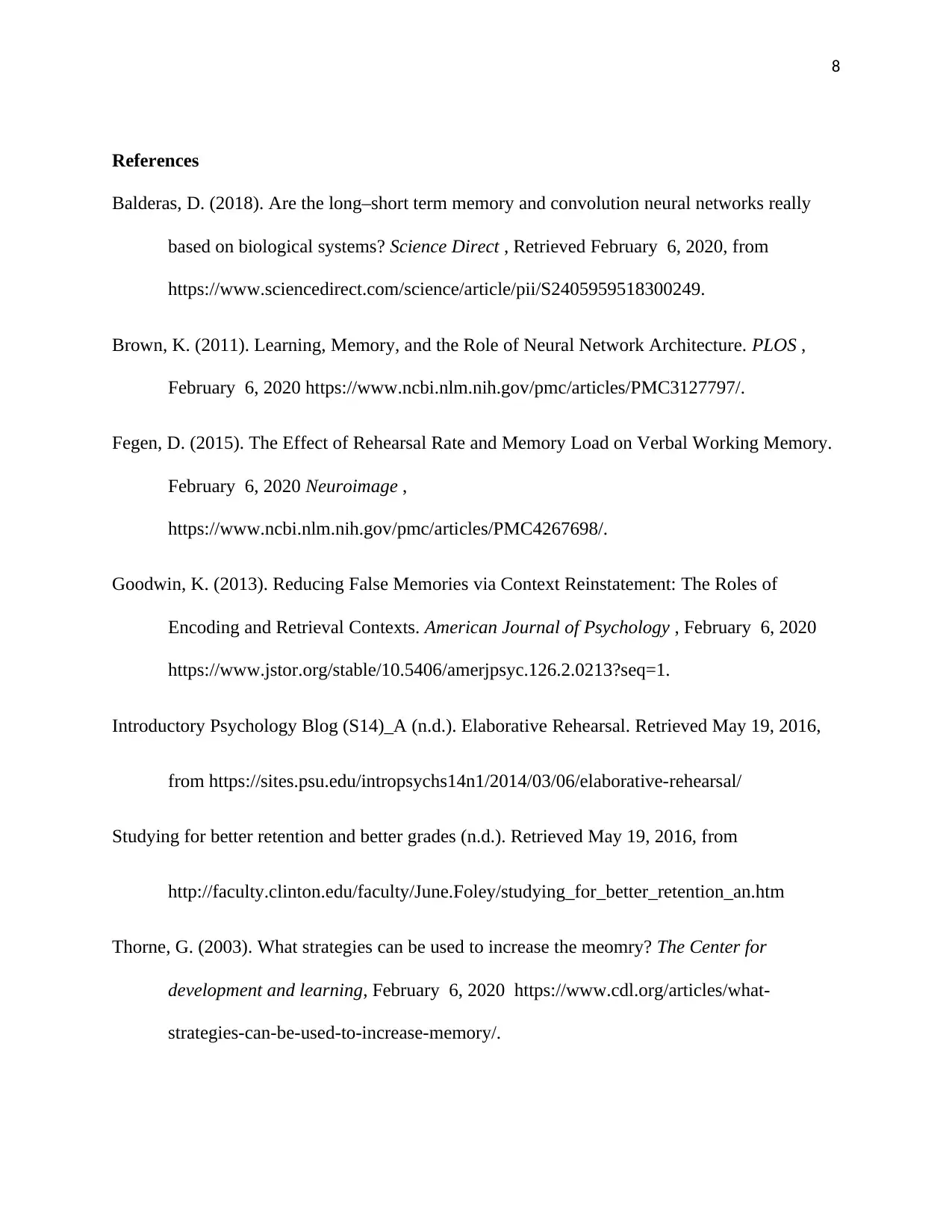
8
References
Balderas, D. (2018). Are the long–short term memory and convolution neural networks really
based on biological systems? Science Direct , Retrieved February 6, 2020, from
https://www.sciencedirect.com/science/article/pii/S2405959518300249.
Brown, K. (2011). Learning, Memory, and the Role of Neural Network Architecture. PLOS ,
February 6, 2020 https://www.ncbi.nlm.nih.gov/pmc/articles/PMC3127797/.
Fegen, D. (2015). The Effect of Rehearsal Rate and Memory Load on Verbal Working Memory.
February 6, 2020 Neuroimage ,
https://www.ncbi.nlm.nih.gov/pmc/articles/PMC4267698/.
Goodwin, K. (2013). Reducing False Memories via Context Reinstatement: The Roles of
Encoding and Retrieval Contexts. American Journal of Psychology , February 6, 2020
https://www.jstor.org/stable/10.5406/amerjpsyc.126.2.0213?seq=1.
Introductory Psychology Blog (S14)_A (n.d.). Elaborative Rehearsal. Retrieved May 19, 2016,
from https://sites.psu.edu/intropsychs14n1/2014/03/06/elaborative-rehearsal/
Studying for better retention and better grades (n.d.). Retrieved May 19, 2016, from
http://faculty.clinton.edu/faculty/June.Foley/studying_for_better_retention_an.htm
Thorne, G. (2003). What strategies can be used to increase the meomry? The Center for
development and learning, February 6, 2020 https://www.cdl.org/articles/what-
strategies-can-be-used-to-increase-memory/.
References
Balderas, D. (2018). Are the long–short term memory and convolution neural networks really
based on biological systems? Science Direct , Retrieved February 6, 2020, from
https://www.sciencedirect.com/science/article/pii/S2405959518300249.
Brown, K. (2011). Learning, Memory, and the Role of Neural Network Architecture. PLOS ,
February 6, 2020 https://www.ncbi.nlm.nih.gov/pmc/articles/PMC3127797/.
Fegen, D. (2015). The Effect of Rehearsal Rate and Memory Load on Verbal Working Memory.
February 6, 2020 Neuroimage ,
https://www.ncbi.nlm.nih.gov/pmc/articles/PMC4267698/.
Goodwin, K. (2013). Reducing False Memories via Context Reinstatement: The Roles of
Encoding and Retrieval Contexts. American Journal of Psychology , February 6, 2020
https://www.jstor.org/stable/10.5406/amerjpsyc.126.2.0213?seq=1.
Introductory Psychology Blog (S14)_A (n.d.). Elaborative Rehearsal. Retrieved May 19, 2016,
from https://sites.psu.edu/intropsychs14n1/2014/03/06/elaborative-rehearsal/
Studying for better retention and better grades (n.d.). Retrieved May 19, 2016, from
http://faculty.clinton.edu/faculty/June.Foley/studying_for_better_retention_an.htm
Thorne, G. (2003). What strategies can be used to increase the meomry? The Center for
development and learning, February 6, 2020 https://www.cdl.org/articles/what-
strategies-can-be-used-to-increase-memory/.
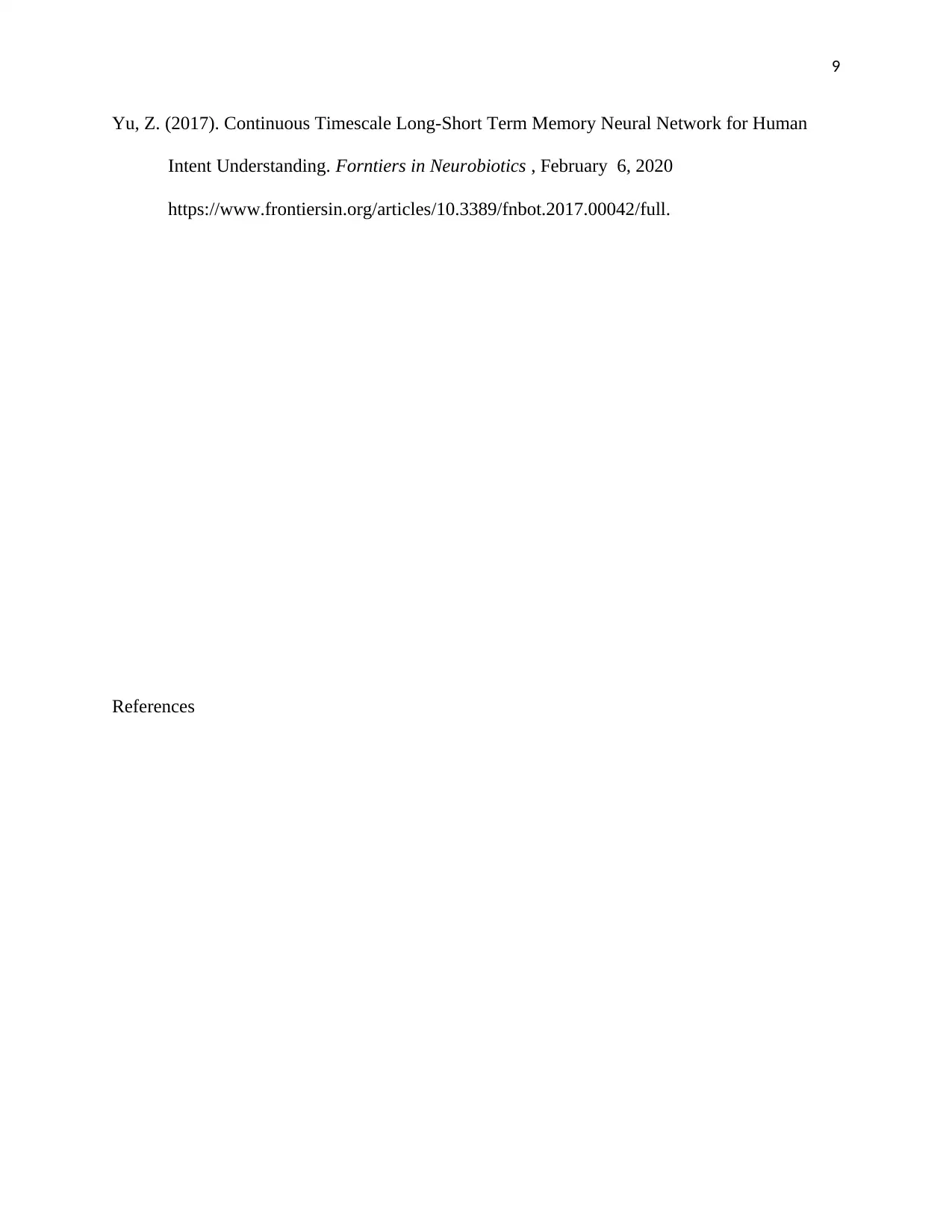
9
Yu, Z. (2017). Continuous Timescale Long-Short Term Memory Neural Network for Human
Intent Understanding. Forntiers in Neurobiotics , February 6, 2020
https://www.frontiersin.org/articles/10.3389/fnbot.2017.00042/full.
References
Yu, Z. (2017). Continuous Timescale Long-Short Term Memory Neural Network for Human
Intent Understanding. Forntiers in Neurobiotics , February 6, 2020
https://www.frontiersin.org/articles/10.3389/fnbot.2017.00042/full.
References
⊘ This is a preview!⊘
Do you want full access?
Subscribe today to unlock all pages.

Trusted by 1+ million students worldwide
1 out of 9
Your All-in-One AI-Powered Toolkit for Academic Success.
+13062052269
info@desklib.com
Available 24*7 on WhatsApp / Email
![[object Object]](/_next/static/media/star-bottom.7253800d.svg)
Unlock your academic potential
Copyright © 2020–2025 A2Z Services. All Rights Reserved. Developed and managed by ZUCOL.
